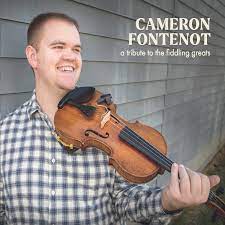Hats off to Cameron Fontenot for releasing a different kind of debut album. Whereas most debut albums symbolize the arrival of new talent, the Cajun fiddler opted for something different by dedicating each tune to a particular fiddler. On nine tracks, Fontenot duets with a fellow fiddler known for a specific repertoire, style, or personal connection to the honoree.
For “Dennis McGee‘s Reels,” the Eunice musician is joined by Blake Miller, known for his expertise in McGee’s material. For hometown fiddlers Wade Frugé (“Caillette est Crevee”) and Wallace “Cheese” Read (“Tu M’as Quitte Dans La Louisiane”), he partners with crosstown homie Joel Savoy, whose family ties run deep with Frugé and Read. Another hometown fiddler honored is Eldridge Aguillard, known for his championing of Chuck Guillory’s “Tolan Waltz.” Gina Forsyth was a natural choice for Tony Thibodeaux’s gliding “Fiddlers Waltz” since she learned and played with Thibodeaux.
Regardless, if it’s a debut album or otherwise, it’s astonishing how meticulously planned it is and the depth of the selections’ connections. Take “Valse de Bamboucheur,” for example. It was one of Dewey Balfa’s first recordings in the early ’50s and was the impetus for Swallow Records honcho Floyd Soileau inking The Balfa Brothers to record its 1967 landmark The Balfa Brothers Play Traditional Cajun Music album. Decades later, “Bamboucheur” became a favorite of Dewey’s grandnephew, the sorely missed Courtney Granger, whom Fontenot salutes here with Dewey protégé Peter Schwarz.
What else is impressive is how Fontenot scoured the terrain for out-of-the-way morsels. “Rosina” wasn’t a huge Balfa Brothers staple but is resurrected, also featuring Schwarz. This rendition is slower than The Balfa Brothers’ peppier version in 1976s J’ai Vu le Loup, Le Renard et la Belette, to underscore the tune’s frolicking and playful nature. “Allons à Lafayette” was a favorite of Ervine “Dick” Richard (Walter Mouton’s longtime fiddler) and learned from a field recording.
“Tolan Waltz” and “Allons à Lafayette” are the only tracks Fontenot plays sans a partner and showcase his sublime technique. Additionally, he’s a pleasant, sturdy vocalist who could sing all night if necessary.
“Draggin’ the Bow,” a tip of the hat to Harry Choates, gets the nod for liveliest track that’s nothing less than a sonic firecracker. Instead of playing solo or as a duo, this time, it’s three fiddlers, Fontenot, Beau Thomas, and Luke Huval, all trading lickety-split lines in an action-packed arrangement. Laine Thibodeaux comes flying in on steel, and Trey Boudreaux snaps a string bass solo before the trio goes out in a blaze of glory for the rip-roaring finale. With this in hand, Fontenot accomplishes his heartfelt mission to honor the sung and unsung on what’s believed to be the first tribute of its kind in Cajun music.



